从熟悉的 axios 上手 Postman
目录
- get 请求
- post 请求
- 避免 400 状态码
一、get 请求
一般 get 请求的传参是把参数包含在 URL 中。浏览器当前的实现是不允许 get 发送 body, 但后端应用可以发送,比如 nodejs 或 postman。前端不能使用 get 方法从浏览器里发送 body,get 请求携带参数一般采用 params 传参。
(1) 在 axios 中发送 get 请求
// 第一种方式
axios.get('/api/getInfo',{
params:{
name:"seven"
}
}).then(res => {
console.log(res)
})
// 第二种方式 直接连接(不推荐)
axios.get('/api/getInfo?name=seven',{
params:{}
}).then(res => {
console.log(res)
})
因为涉及到跨域问题,还需要在 vue.config.js 中做一个代理。
module.exports = {
outputDir: "dist",
assetsDir: "assets",
lintOnSave: false,
devServer: {
open: true,
host: "localhost",
port: "8081",
https: false,
hotOnly: false,
proxy: {
// 当访问 /api/xxx 时会被代理到 http://localhost:8080/xxx
"/api": {
target: "http://localhost:8080",
ws: true,
changeOrigin: true,
pathRewrite: {
"^/api": "",
},
},
},
},
};
(2) 在 Postman 中发送 get 请求
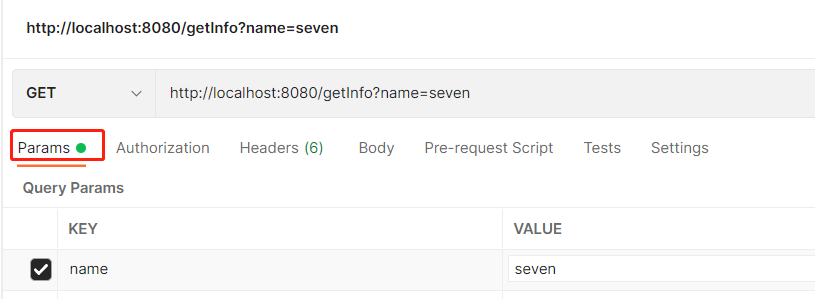
二、post 请求
POST 请求的消息主体放在 body 中,服务端根据请求头中的 Content-Type 字段来获取消息主体的编码⽅式,进⽽进⾏解析数据,这里主要介绍比较常用的 3 种类型。
1 application/x-www-form-urlencoded
最常见的 POST 提交数据的⽅式如果不设置 content-type 属性,默认为 application/x-www-form-urlencoded ⽅式提交数据,提交的表单数据会转换为键值对并按照 key1=val1&key2=val2 的⽅式进⾏编码,其中 key 和 val 都进⾏了 URL 转码。
(1) 在 axios 中发送 post 请求 (application/x-www-form-urlencoded)
// 第一种方式
// npm install qs --save 安装qs库
import qs from 'qs'
axios.post("/api/sendInfo", qs.stringify({
name:'seven',
})).then((response) => {
console.log(response.data);
});
// 第二种方式(不推荐)
axios.post("/api/sendInfo","name=seven").then((response) => {
console.log(response.data);
});
(2) 在 Postman 中发送 post 请求 (application/x-www-form-urlencoded)
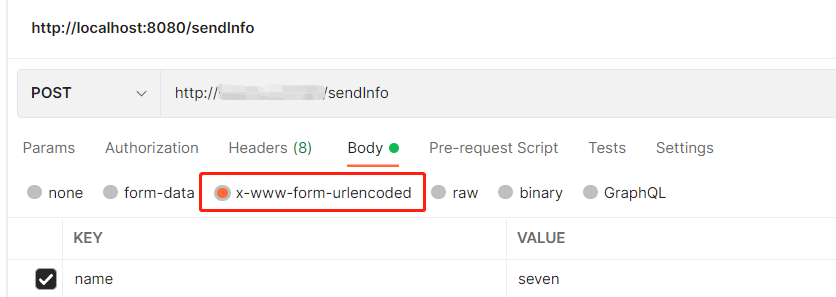
在 postman 中选择 body 下的 x-www-form-urlencoded 请求头会自动变成 Content-Type:application/x-www-form-urlencoded,无需我们手动在去修改请求头。

2 multipart/form-data
另⼀个常见的 POST 数据提交的⽅式,Form 表单的 Content-Type 设置为 multipart/form-data,它会将表单的数据处理为⼀条消息,以标签为单元,⽤分隔符分开。由于这种⽅式将数据有很多部分,它既可以上传键值对,也可以上传⽂件,甚⾄多个⽂件。
(1) 在 axios 中发送 post 请求 (multipart/form-data)
axios 在传递 json 序列化参数的时候默认的请求头是 application/json,所以在请求类型是 multipart/form-data 的时候需要单独指定请求头,否则就会变成 application/json。
// 需要手动设置请求头
let data = new FormData();
data.append('name','seven');
let config = {
headers: {
'Content-Type': 'multipart/form-data'
}
}
axios.post("/api/sendInfo", data, config).then((response) => {
console.log(response.data);
});
(2) 在 Postman 中发送 post 请求 (multipart/form-data)
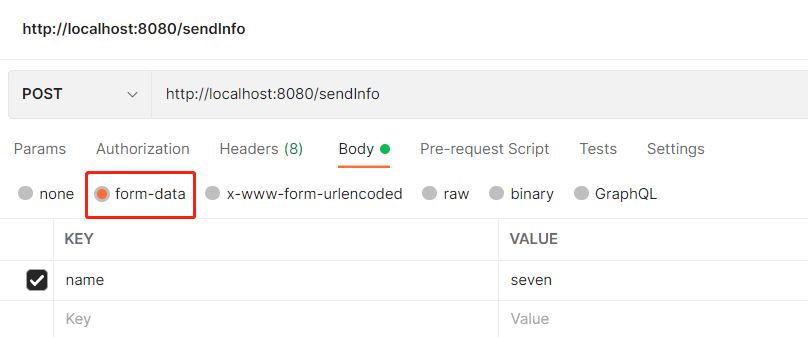
postman 中选择 body 下 form-data 请求头会自动变成 Content-Type:multipart/form-data,无需我们手动在去修改请求头。

3 application/json
Content-Type: application/json 作为响应头⽐较常见。实际上,现在越来越多的⼈把它作为请求头,⽤来告诉服务端,消息主体是序列化后的 JSON 字符串,其中⼀个好处就是 JSON 格式⽀持⽐键值对复杂得多的结构化数据。
(1) 在 axios 中发送 post 请求 (application/json)
axios.post("/api/sendInfo", {
name: "seven",
})
.then((response) => {
console.log(response.data);
});
(2) 在 Postman 中发送 post 请求 (application/json)
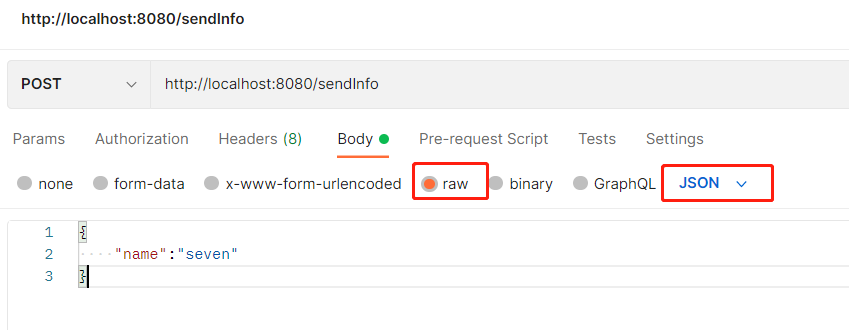
在 postman 中选择 body 下的 row 右侧类型选择 JSON 请求头会自动变成 Content-Type:application/json, 无需我们手动在去修改请求头。
注意:写内容的时候一定要是标准的 JSON 使用双引号。
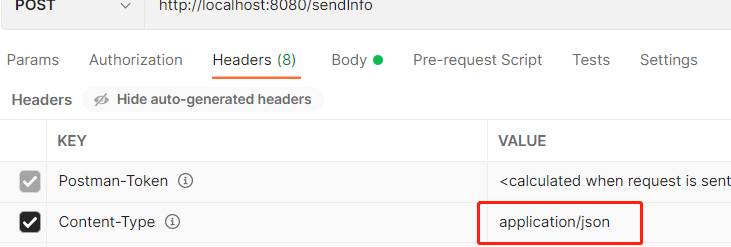
注意
如果有二进制(非字母数字)数据(或相当大的有效载荷)要传输,请使用 multipart/form-data,其他情况建议使用 application/x-www-form-urlencoded 或者 application/json。
三、避免 400 状态码
很多时候接口调试得到 400 报错,很有可能就是传参设置不正确。出错时,不妨回过头来检查下是否格式正确。



